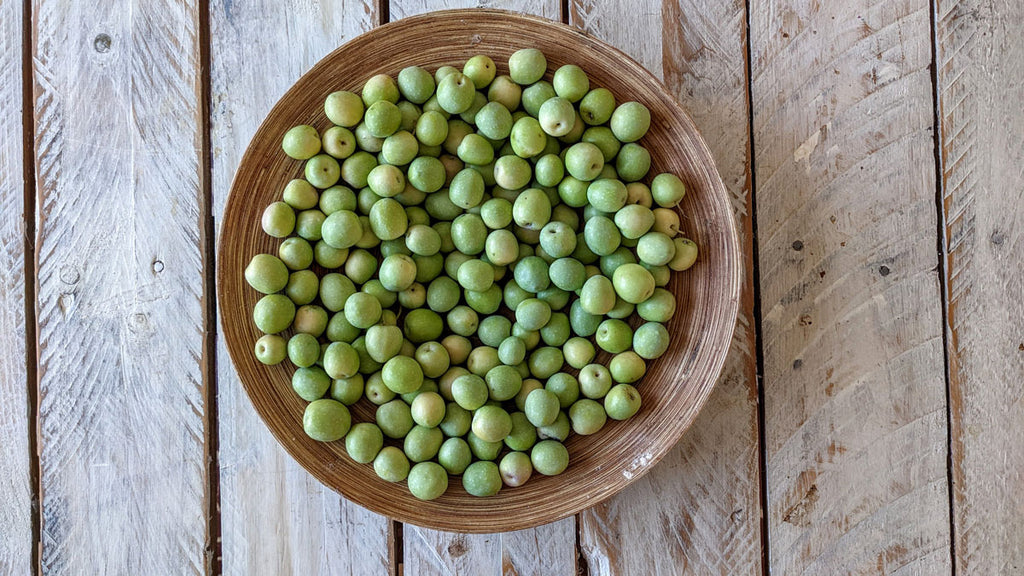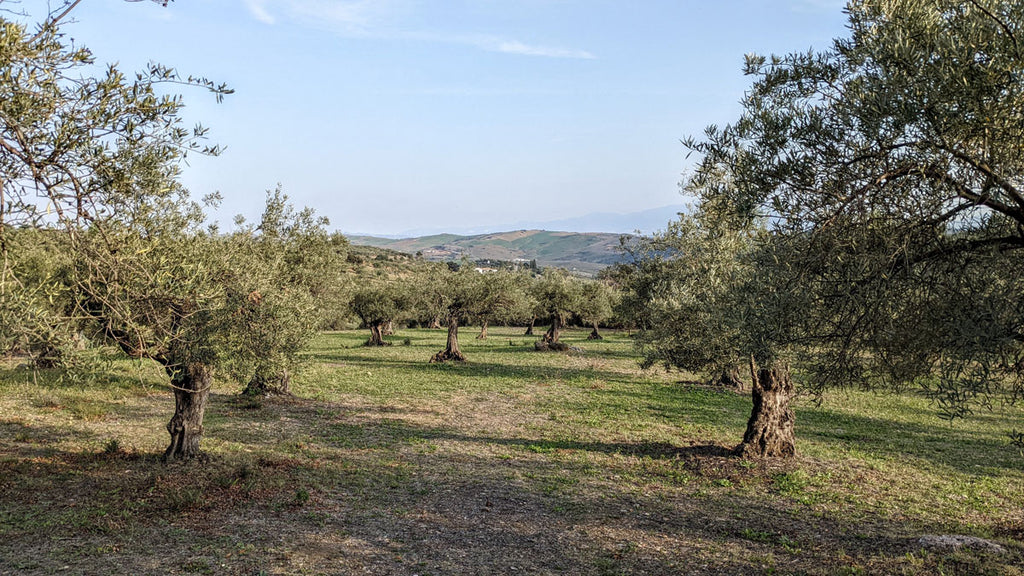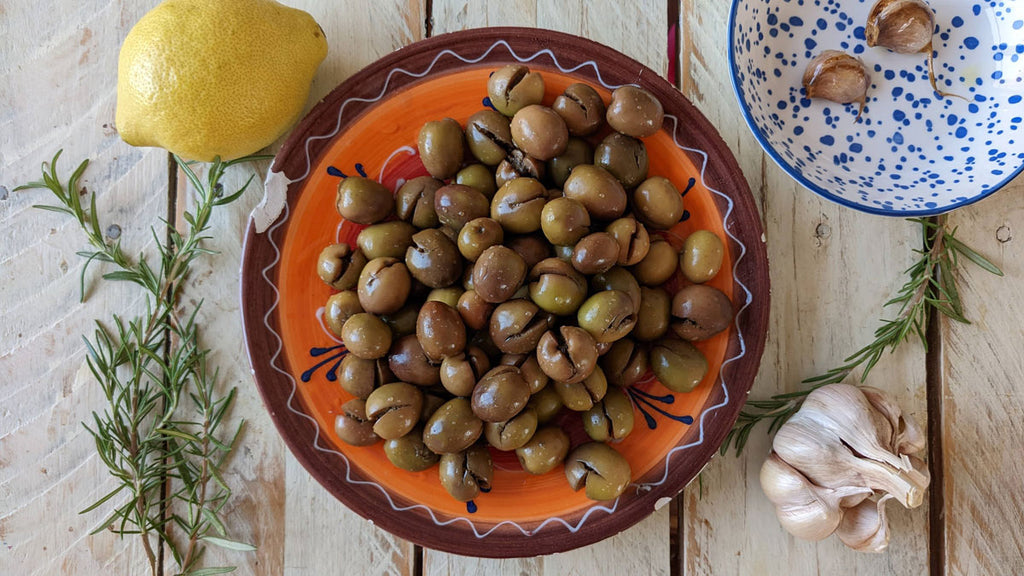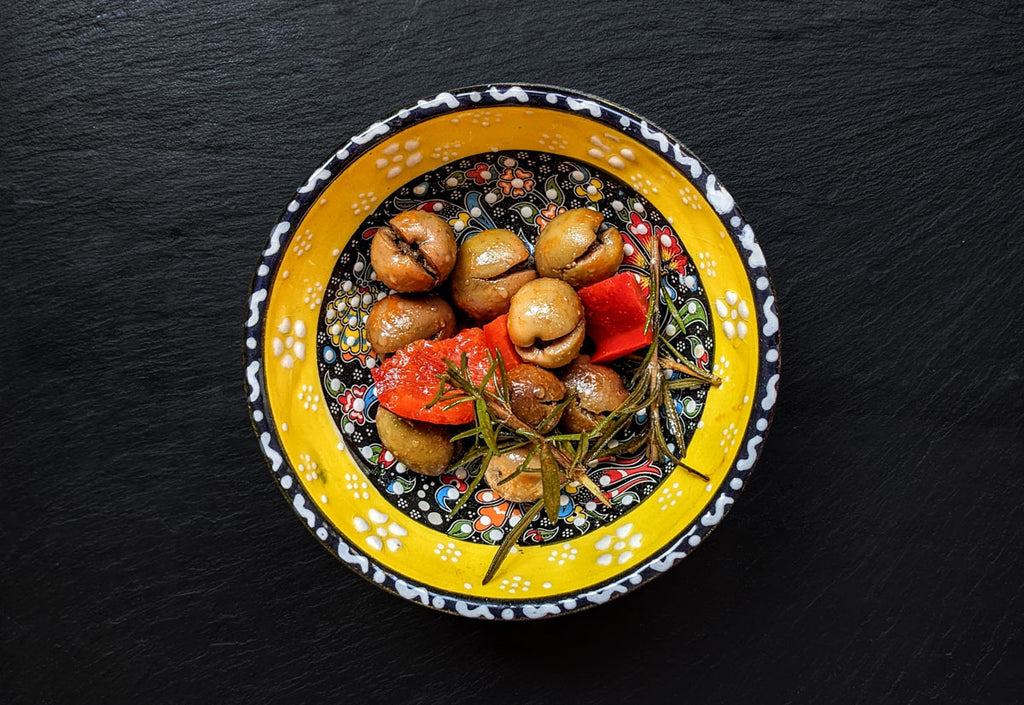
Our Guide to Help You Preserve Olives at Home
A detailed recipe for pickling fresh olives from plucking them from the tree, through de-bittering them in a water bath to the final pickling. You can also use the last stage to flavour canned olives that you buy in a shop.
TO BEGIN WITH...
Olives are actually the fruit of the olive tree. Resembling in shape and texture a sort of hard green cherry, yet filled with the healthiest oil, truly nutritious, and more anchovy-like in character when pickled than any fruit.
Historically, only cold water was used for their processing, and their preparation was therefore uniquely simple. With just the right ratio of water and salt, you soon had an excellent permanent food from the initially inedible fruit that carried you beautifully from one harvest to the next.
HOW DO FRESH OLIVES TASTE?
When you visit Spain, Greece or Italy, try to pick a fresh olive straight from an olive tree and taste it. Simply disgusting! Extreme bitterness with extreme astringency makes it practically impossible to perceive any other taste.
Only after a weekly water bath do the olives gradually lose their bitterness and astringency and slowly become acceptable.

Freshly picked olives that have not been soaked are practically inedible
HOW ARE OLIVES HARVESTED?
Various methods are used for professional olive production, from machines that shake the olives into stretched nets to the careful manual picking of olives one by one.
We picked olives directly from the olive trees of our friends who have a house in the south of Spain with an olive grove.

Olives are collected from the end of September to the end of the year, depending on the climate and the variety of olives
When picking olives, care must be taken to ensure that all olives are healthy and intact. One bad olive can spoil the whole batch.
OLIVES WITH OR WITHOUT STONES?
Pitted olives have only one advantage over the unpitted olives. They have no stones. Everything else is wrong. The stone helps the olives retain most of their flavour and preserves the original texture of the olive flesh. Pitted olives can be stuffed with anchovies or peppers, but this is only done because they have no flavour on their own.
In Spain, you will almost never find pitted olives on the menu of any restaurant, although there are often plenty of them on offer in stores. You could say that pitted olives in Spain are a sign of bad taste.
Think about the unpitted olives you've eaten. Were some of them whole, as if they had just been picked from a tree, while others were crashed with a stone hanging out, as if someone had stepped on them?
Whole olives last longer, but it also takes longer to drain the bitterness from them. They have a purer taste of the original fruit, because they absorb the aroma from the spices and herbs in the pickle more slowly.

Split open olives facilitate the penetration of the aromatic varnish into the flesh, while preserving the olive whole. However, we recommend crashing the olives completely.
THE COLOUR OF OLIVES
The olives on the tree are green at first. With gradual ripening their colour changes from violet to dark purple, until at the very end, when it reaches an almost black colour.
For processing, with few exceptions, green olives are used, which are either pickled as they are, or subjected to an oxidation process that turns them into black olives, which are often found in supermarkets.
Most of the black olives produced in Spain are exported to Italy. It is said that the oxidation process turning green olives black was introduced so that even the worst quality olives could be used too. This is also why oxidized black olives often taste bad.
Black olives, which have acquired their colour by ripening on the tree, are something else. On the contrary, they are full of intense flavour. However, if you find black pitted olives on your plate, you can be almost 100% sure that these are oxidized olives.

Green olives are already fully ripe and are best suited for pickling. In the later stages of maturity, the olive turns purple and finally a dark purple to black colour.
RECIPE: HOW TO PICKLE OLIVES?

Olives after being soaked in water for a week
INGREDIENTS:
Serves 4
- 500g of fresh green olives
- 35g of salt
- 1 teaspoon ground paprika
- 1 teaspoon of cumin
- 2 sprigs of rosemary
- 2 cloves of garlic
- 1/4 red bell pepper
- 1 tablespoon wine vinegar (optional)
- zest of 1/2 lemon (optional)
- water for soaking + water for pickling
METHOD:
- First clean the olives and discard any that are not perfect. They may have a spot or they may be slightly rotten.

The initial olives check is important because a few bad olives can spoil the whole batch
- Wash the olives carefully under running water and remove all branches and any dirt.
- Now comes the stage of preparing the olives for water curing. You can either leave the olives whole, or you can cut them on several sides, or you can crack them with a wooden mallet or the pressure of a sturdy mug. We recommend the last option, because in this way the olives get rid of their bitterness faster in the pickle and better absorb the aroma of the pickle. The disadvantage is that they don't last as long as whole olives.

Olives ready for pickling - whole olives on the left, split open, and cracked.

Olives are traditionally cracked by tapping with a wooden mallet. You can also use a mug or a sturdy glass, which you press on the olive until it cracks.
Curing the olives in water

- Now comes the soaking phase. Place the olives into a sufficiently large bowl or bucket (the containers must not be made of metal) and cover them with fresh water. Cover the bowl. Change the water every day, even twice. If you work with open olives, they should lose their unpleasant bitterness after 7-8 days. Taste one olive, and if it's not bitter, you can skip to the next step. If it is bitter, you continue to soak it further. Remember that open olives get soaked the fastest, followed by split open olives. The whole olives take the longest, ten or more days.

Olives lose their fresh green colour during soaking. It's normal. Never use metal tools or containers.
- Drain the de-bittered olives and give them a final rinse. Prepare a container in which the olives can fit tightly with about 300 ml of water. Mix 35g of salt in 300ml of water (ideally non-chlorinated) - not even a grain should remain at the bottom. Note you need to prepare more salt water, follow the same ratio.
- Place the first layer of olives, 4cm fresh rosemary stalk, sprinkle with paprika and cumin, add 2-3 cloves of fresh (or roasted) pepper and sprinkle with a few drops of vinegar (alternatively, a 2cm lemon peel). Repeat until the glass is full. In the first and second thirds - insert one unpeeled clove of garlic (it can be fried in olive oil and cooled). Cover with salt water. If the glass is not filled to the brim with water, add the same salty pickle in the same ratio as mentioned above.

The olives and spices are added layer by layer
- Close the jar and let it stand in a cold room for one week. You should store olives in the refrigerator and eat them within 2 months.
 Pickled olives last at least 2 months
Pickled olives last at least 2 months

BUEN PROVECHO!
See more recipes on JAMON.CO.UK BLOG
